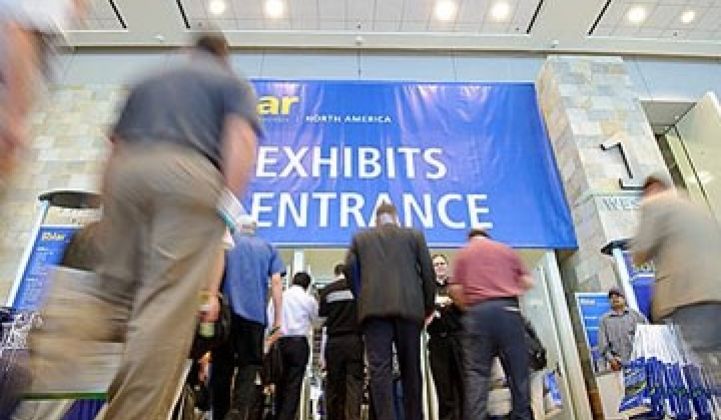I moderated a panel session with a number of growth-stage solar companies presenting at the recent Intersolar event in San Francisco and wanted to give a quick rundown of some of their major points. Here goes:
Solexant
Damoder Reddy, CEO
- Solexant's recent $41.5 million funding round was "one of the few up-rounds in the solar industry," according to the CEO.
- The firm has "built most of the production equipment on their own" and is projecting costs "well below 50 cents per watt."
- The firm is going to market with cadmium telluride on metal foil but is essentially material agnostic.
- Their nano-crystal in a solvent ink on a roll-to-roll line allows significantly larger module sizes.
- The can make a 6 amp module and show a huge savings in cabling cost versus First Solar because of higher amperage.
BrightSource Energy
Charles Ricker, Senior Vice President of Business Development
- BSE is producing steam for power but has also added production of steam for Thermal Enhanced Oil Recovery (TEOR) -- there is now a TEOR demo plant under construction.
- The power block is 55 percent to 60 percent the cost of the plant. BSE uses an air-cooled power block, which results in an efficiency penalty but uses less water and makes permitting easier.
- According to Ricker, a typical golf course uses more water than their Ivanpah plant will use.
- "You have to go from the PowerPoint business to the Power Plant business"
- BSE's "secret sauce" and key IP is the software needed to control 60,000 heliostats and the 120,000 mirrors in a solar field
- Ricker claimed a solar-to-thermal efficiency of 54 percent
Stion
Chet Farris, CEO
- Stion now has 85 employees and their CIGS-based product will offer "silicon efficiency at thin film costs."
- Farris has a long career in solar and is "not a big fan of amorphous silicon." It was a "dead duck ten years ago" and "is a dead duck today." It will be "relegated to specialty and niche markets."
- Stion has demonstrated 13.4 percent efficiency on full-size panels with their single-junction product.
- Stion is currently producing 2-foot-by-5-foot panels at 120 watts to 130 watts for all solar sectors.
- The firm has a roadmap to 15 percent efficiency and is sold out of short-term capacity.
- Farris claims that the firm has 150 megawatts of purchase commitments and their partnership with foundry TSMC will result in a 100-megawatt expansion.
- Farris also claimed that they can get to market in "half the time and with one-tenth the money."
AQT
Michael Bartholomeusz, CEO
- AQT is on the contrarian side of CIGS panel manufacturers -- they are not going after monolithic assembly but instead want to be "a drop-in replacement for crystalline silicon."
- The firm is using established dry sputtering equipment to manufacture their cells.
- AQT has gotten to strong efficiency figures in a very short two years after having spent less than $15 million.
- They see themselves at a lower ASP than First Solar and still perserving a 50 percent gross margin.
Enphase Energy
Paul Nahi, CEO
- Micro-inverter company Enphase had a 12.6 percent U.S. market share in the first quarter of 2010.
- The firm has 115 employees and a multi-megawatt pipeline.
- In the CEO's words, "A microinverter is not a miniature central inverter."
- On reliability: "The only reliability data that matters is empirical," "We are the most reliable inverter on the market today," "Reliability is king."
- "Many large companies use your balance sheet as a proxy for your credibility."
- "Selling to a module manufacturer is a more painful process than selling to a retail customer -- we are just today at a point where module manufacturers think they can trust us."
Tioga Energy
Paul Detering, CEO
- Solar PPA company Tioga's CEO does not believe in the feed-in tariff approach; in his viewpoint, it's always priced incorrectly.
- "We need to drive down cost."
- A colleague of Detering, regarding the subsidy and policy structure of the industry had this to say: "I've never seen a more dysfunctional industry than the renewable industry."
- Detering cited the recent examples of his firm's work at the Athenian School using the Morris Model.
Clean Power Finance
Joseph Brakohiapa, CEO
- CPF sells Software-as-a-Service to solar installers to ease the paperwork morass -- there are typically three to six hours of rebate paperwork on every solar job.
- The goal "is to get solar beyond the early adoption stage."
- According to the CEO, "7,000 folks use our product" and the firm sees more roofers and HVAC people getting into the solar installation business.
- One of the CPF's goals is to enable Point-of-Sale Financing.
***
Headline with apologies to The Nails



